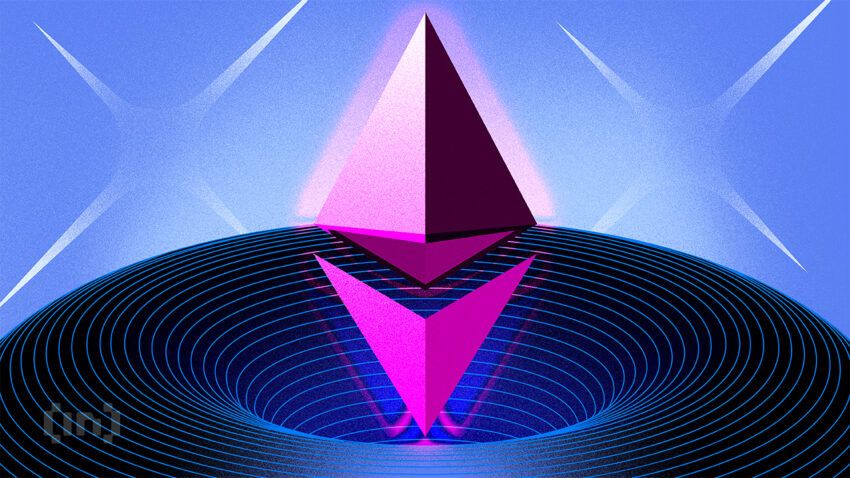Staking Ethereum is a good method to profit from one of the world’s most popular cryptocurrencies. It is also a sound way to support the network and the growing ecosystem. However, staking Ethereum requires either technical knowledge or — more likely — an informed opinion about the platforms that offer assistance.
Is the decision to switch from a mining model to a staking model something you should be concerned with? Can you still earn a profit from staking ethereum in 2025? Our detailed guide will look at the best platforms that cater to Ethereum staking.
Want to get reviews on the best projects for ETH staking? Join BeInCrypto Trading Community on Telegram: read reviews, discuss crypto projects, ask for technical analysis on coins and get answers to all your questions from PRO traders & experts! Join now
What is Ethereum staking?
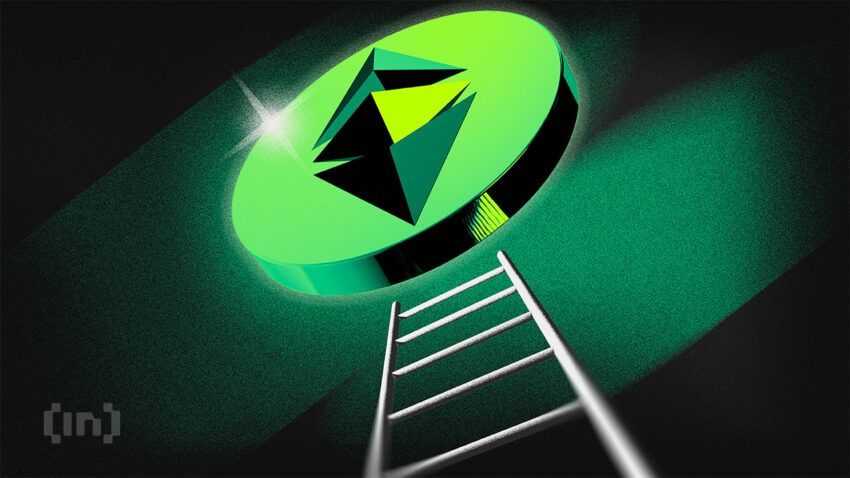
Ethereum is one of the most valuable and popular coins in the crypto market. Although this currency can be bought and sold on many platforms, staking is only worthwhile in certain conditions.
Overburdening the Ethereum (ETH) network has caused transaction costs to soar to prohibitive levels in most cases. Ethereum 2.0 (or ETH2) is a multiphased upgrade. It aims to increase the security and scalability of the network by significantly making infrastructure modifications. This includes switching from a proof-of-work (PoW) to a consensus proof-of-stake (PoS) model.
Ethereum currently handles 15-30 transactions per second. This is a slow speed in comparison to traditional financial transactions.
ETH 2.0
Ethereum 2.0 — also known as “Eth2” or “Serenity” — is an upgrade to Ethereum’s blockchain. This upgrade was intended to improve the speed, efficiency, and scalability of the Ethereum network.
The goal was to process more transactions and reduce bottlenecks. Essentially, it was a move that made the blockchain more efficient. The ETH2 upgrade finalized in September 2022.
Ethereum investors who decide to secure their assets will help ensure the security and governance of the network. A “validator” or “Ethereum Staker” is someone depositing ETH. They are responsible for processing transactions as well as adding new blocks to the blockchain.
This person receives a staking reward for their effort. As a strategy similar to Bitcoin mining or lending to earn passive cryptocurrency, ethereum staking can be used to earn passive income.
Top 9 platforms to stake Ethereum
1. Rocket Pool
Rocket Pool is an Ethereum 2.0 stake pool. This protocol lowers both capital and hardware requirements to stake on ETH 2.0. It also adds to the security and decentralization of Ethereum as a network.
The protocol’s main purpose is to serve people who wish to stake and those who want to run their own nodes. The platform provides infrastructure and liquidity for quick withdrawals and low staking requirements. RPL token is the protocol’s monetary and governance token.
David Rugendyke established Rocket Pool in 2016. It became apparent that Ethereum would shift from a proof-of-work to a proof-of-stake consensus mechanism.
Rocket Pool relies on smart contracts to ensure a trustless and permissionless structure. Furthermore, the network’s DAO allows for decentralized governance managed by its users. The unique network DAO connects the main ETH1 framework to the beacon chain. This allows those with limited financial resources to reap the staking benefits and increase their ROIs.
Block rewards are not guaranteed on ETH1 until a new block is found. Validators on the ETH2 network use a clear schedule. The ETH2 network retains the rewards earned by validators.
Rewards distribution
To earn rewards with Rocketpool, users can deposit as low as 0.01 ETH. Upon trading ETH, users receive rETH. This token offers rewards over time based on how decentralized node operators perform. The token can be traded, lent, or used as collateral.
Rocket Pool nodes require only 16 ETH per validator, unlike solo stakers who must stake 32 ETH. The 16 ETH is then added to the staking pool. This is known as a mini pool. The Beacon chains recognize them as regular validators when they are together. Rocket Pool’s smart contracts for the ETH1 chain handle all the withdrawals, rewards, and delegation. This makes them fully decentralized.
You get an ETH token in exchange for staking it. You will receive 10 rETH if you deposit 10 Ethereum on Rocket Pool. Your exchange value will increase as the Beacon chain balance increases over time due to validator rewards.
rETH is a liquid, yield-bearing ERC-20 token that represents 1 staked ETH. Users can do whatever they like with their rETH as long as ETH assets remain staked to Rocket Pool node operators. This allows you to interact with other DeFi protocols.
What you should know
Rocket Pool is one of the very first decentralized Ethereum staking platforms. Funds are kept safe from the node operators by using audited smart contracts that are open-sourced and audited. Investors can trade amounts of Ethereum for Rocketpool’s rETH tokens. The amount of Ether staked in these pools are represented by the rETH token. It can accrue value over time.
Rocket Pool instantly provides users their rETH token upon depositing. This tokenized staking deposit earns rewards over time and does not need to be stored up. Users can trade, sell or keep it at any time to provide liquidity for our users.
RPL is the primary protocol token and will be used for governance of the protocol. It can also be staked on Rocket Pool nodes as insurance. It is available on the likes of Uniswap, CoinEx, or Bvnex.
2. Lido
Lido is an Ethereum-based liquid staking platform that allows users to stake as much Ethereum as they wish. It does not lock funds. It’s important to remember that Lido is not an exchange in the classic sense.
Recent estimates have shown that Lido holds over 85.3% market share for Ethereum liquid staking. Lido’s growth was 15,000% in 2021. It’s an encouraging sign concerning the public’s willingness to stake Ethereum.
Rewards distribution
Lido also operates as a DAO. Deposited ETH is distributed among industry-leading, reputable node operators who are members of the DAO. Users will receive staked ETH (ERC20 token) when they stake via Lidos’s pool. This represents their deposited Ethereum, as well the rewards and possible penalties.
The entire process is simple, and users can stake Ethereum with Lido to earn a 3.7% APR. Users who stake with Lido receive stETH tokens in a 1:1 ratio. This corresponds to the amount of their staked Ethereum. Lido users can profit from their stETH balances to earn yields or to lend funds. The balances reflect daily ETH staking rewards.
What you should know
LDO is the governance token of Lido’s DAO. It allows its holders to participate in community voting and make other decisions about the protocol’s future. Presently, the token is listed on several high-profile exchanges, including Binance and Gemini.
Lido is gaining popularity because of a few reasons. Staking is less risky. It is, however, also less profitable than investing in some of the standard Decentralized Finance (DeFi) products. A user could stake their Ethereum today by either putting up 32 ETH or using a central exchange such as Coinbase or Binance in order to pool their coins.
Through its decentralized staking platform, Lido hopes to address both of these problems. There is no minimum deposit to join a stake pool. Lido requires, however, a 10% stake fee. The earnings contain the deductible fee.
3. Kiln
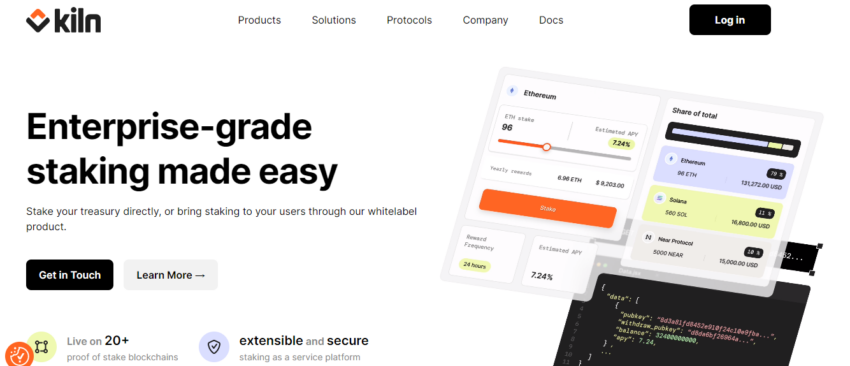
The leading enterprise-grade staking platform allows institutional customers to stake assets and integrate staking functionality into their offerings. Their API-first platform allows fully automated validator, reward, and commission management.
Kiln offers a full suite of staking services that can be used together or separately. This makes it simple to expand your staking offering. Their admin staking dashboard lets you view, track, bill, and automate your stakes from a single location. They also provide white-labeled and direct staking via their API solutions.
Additionally, they serve diverse institutional clients, including custodians, wallets, exchanges, market makers, funds, banks, and anyone dealing with cryptocurrencies. Kiln also runs all of its validators in-house, which is equally impressive. They have an engineering team dedicated to deploying, monitoring, and maintaining thousands of validators across all major PoS chains.
You can keep custody of your assets in any crypto wallet or custodian solution you prefer. Kiln’s staking platform is non-custodial, meaning you can only access your funds by controlling the underlying wallet that holds a claim to them.
Rewards distribution
Staking rewards accumulate automatically as soon as the validator is turned on. Some rewards are liquid and immediately available (so-called execution-layer rewards, consisting in about half the yield). This is approximately 5.34% APR on Kiln. The remaining portion is ‘locked’ until withdrawals on the Ethereum network are enabled. Kiln charges a degressive operating fee on rewards based on the staked volume. This starts at 8% of the staking rewards.
What you should know:
Kiln utilizes many cloud service providers, such as GCP, Cloud, AWS, Azure, Scaleway, and OVH. They are live on more than 20 blockchain networks and protocols. The company is founded and operated by tech industry vets from companies such as Consensys, Polygon, Ledger, and Chainalysis, to name a few.
4. Coinbase
Coinbase is an online platform that allows users to buy, sell, transfer, store, and transfer digital currency. It is also one of the most famous of its kind. Brian Armstrong founded the platform back in 2012. The exchange is one of the leaders of the international crypto financial system. It also offers a variety of crypto services for its millions of customers.
Coinbase does not require a minimum balance for users to be able to stake Ethereum. It aggregates tokens from investors to run nodes.
Rewards distribution
Many view Ethereum staking as a method to reduce their potential losses caused by price volatility by taking out stake rewards. In other words, users still get passive rewards even if their coins lose value.
On Coinbase, users can earn as much as 3.65% on staked Ethereum. Coinbase has no minimum ETH stake requirement. This strategy is particularly useful for crypto investors mindful of the occasional price drops in the value of assets.
Coinbase makes it easy to join a staking pool. These staking pool rewards can be in the form of Ethereum.
What you should know
Coinbase charges a 25% commission for any rewards earned through staking. Currently, Coinbase also prohibits users from staking in many countries. This can prove to be problematic for some.
5. Allnodes
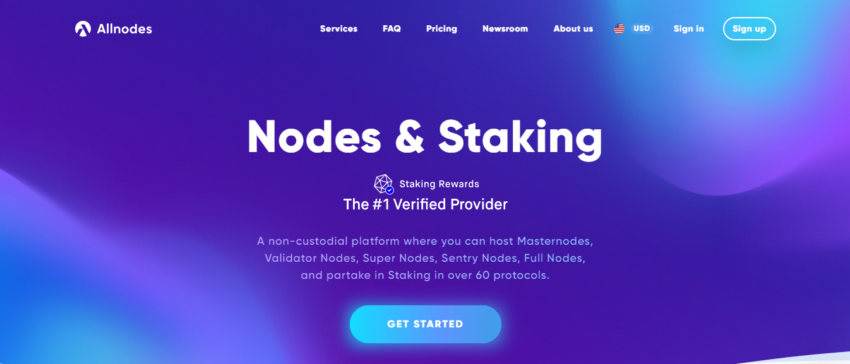
Allnodes is a one-click solution for all of your nodes and staking needs. With their non-custodial platform, users can host masternodes and full nodes using their cloud service. The users can stake their tokens and receive rewards. Allnodes, founded in 2017 in Los Angeles, California, currently supports over 33,000 hosted nodes in more than 60 protocols, with a total valuation of over $2 billion.
The platform is renowned for its user experience. Allnodes allow you to monitor your nodes and other products using a simple user interface. The best part about staking with this revered platform is that the service only requires a wallet address. Because their staking service is non-custodial, your coins stay in your wallet.
For those who stick around long-term, Allnodes offers unique incentives. So, if you pop in and out, you may miss out on all the treasures they offer. Allnodes also offer masternoding services. Masternoding is like staking for proof-of-work blockchains.
Rewards distribution
Allnodes staking services vary between blockchain networks. For ETH 2.0, validators can expect around 4% APR. They charge a low fee of $5 per month. Allnodes has thousands of hosted Ethereum nodes valued at about $800 million. There are no setup fees and the user is billed monthly.
What you should know
Allnodes hosting and staking services are built on a highly sophisticated and secure platform that guarantees 99.9% uptime, allowing their users to take advantage of free maintenance and updates, free node monitoring, reward alert notifications, and additional, multi-level privacy and key protection options.
6. Binance
Binance is the biggest digital currency exchange in terms of trading volume. It is a top choice for investors regarding crypto trading platforms. The Binance staking platform for proof-of-stake coins, such as Ethereum 2.0, appeared in December 2020.
The exchange also supports DeFi staking. It can accommodate cryptocurrencies such as DAI, Tether, Binance USD (BUSD), BTC, and Binance Coins (BNB).
Naturally, staking has the benefit that users can earn more crypto assets and the interest rates can be extremely generous. You may earn as much as 10% or 20% annually in some cases on more established coins. Many crypto users see this as a good way to invest their money. Utilizing the staking mechanisms on sites like Binance is, usually a straightforward process.
Rewards distribution
Users can earn staking rewards up to 5.20% APY from Ethereum on Binance.
Binance offers a variety of interest-earning programs. Users can use the Flexible Savings option to add their crypto and earn interest, with the option to redeem funds at any time. Once a user subscribes, they’ll receive Flexible Savings assets. The interest calculation begins on the second day. This option will give you an approximate APY of 0.3% to 4.4%.
On the other hand, Locked Staking is when funds are held in cryptocurrency wallets to support the operation of a blockchain network. These funds are essentially locked for a set period.
What you should know
Binance doesn’t charge fees to lock funds or stake your tokens. The exchange’s offered APYs are usually lower than those received when staking tokens directly on blockchains or wallets of projects. The APY for staking Ethereum is, however, one that makes the option worthy of consideration.
Users will not earn staking rewards if they redeem their staked coins earlier than the lock-up period. It usually takes 1–2 days to redeem the coins, both in the early redemption phase and at the end.
7. Stakewise
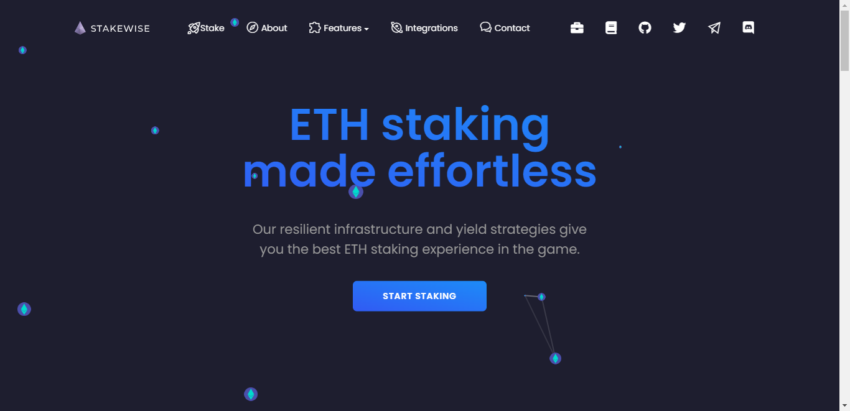
Unlike many ETH 2.0 staking platforms, Stakewise is a non-custodial staking solution. It is a pool supported by a network of leading validators for stakers on Ethereum. Because it is a decentralized application (DApp), anyone can deposit ETH into the pool.
One of the flagship products of Stakewise is LSDs. That’s right! Instead of holding ETH, Stakewise offers a liquid staking derivative for the staked token ETH. With this, traders can speculate or arbitrage in DeFi protocols.
To continue, Stakewise also has a solo staking option. If you are holding 32 ETH, you can become a solo staker. This allows non-technical enthusiasts the option of staking without the hassle of setting and operating a full node. For each new block of 32 ETH, a new validator is created; this is true for both pool and solo stakers. That means you can run as many validators as you want.
Stakewise charges a monthly fee of 10 DAI per validator and provides a one-of-a-kind billing method for handling regular payments for your validators without linking a credit card.
Rewards distribution
After completing the activation stage of the Beacon Chain, the newly created validator begins earning rewards for StakeWise Pool stakers. StakeWise mints an equal amount of reward ETH (rETH2) for every ETH earned as a reward by the Pool. It is accrued to staking ETH (sETH2) holders every 24 hours.
The rewards distribution is 100% minus a 10% commission fee. All rewards are collected in ETH; both rETH2 and sETH2 are backed by ETH 1:1. sETH2 is received when you stake. Likewise, rETH2 is received when your rewards are distributed. Both tokens are built using the ERC-20 standard.
What you should know
In the spirit of true decentralization, Stakewise also has a DAO for governance. You can gain voting power by staking with stakes. This ensures that the platform decision-makers have skin in the game. Furthermore, Stakewise has a DAO treasury and the $SWISE token. This staked token allows participators governance in the DAO.
8. stake.fish

As one of many staking services where you can pool your resources with individuals, stake.fish is a much-needed solution. Here, there are multiple staking options. You can stake on the Ethereum blockchain and other networks, such as Polkadot, Cosmos, Solana, Tezos, and Cardano, to name a few.
Since 2018, Stakefish has operated validators. They support over 20 protocols and have assisted in staking over $1 billion in assets for institutional and retail investors. Their Protocols Team thoroughly examines all governance proposals on every network they support. They base their votes on the long-term consequences of each network.
Stake.fish communicates its vision and recommendations to their delegate community via appropriate media channels and social media. Their top priority is the network’s health and robustness, which is aligned with supporting cryptocurrency and blockchain principles such as decentralization, self-sovereignty, censorship, and immutability.
Reward distribution
The terms of staking differ for each protocol you stake with on the platform. For Ethereum validators, there’s an expected rate of return between 4%-8%. Some staking services take a percentage-based commission; however, stake.fish only takes a 0.1 ETH commission for the Ethereum blockchain.
On their platform, staking rewards are distributed every block. This comes out every ~14 seconds. The unbonding period is 2048 epochs. This works out to about nine days.
What you should know
Their staking infrastructure is hosted on public clouds in various regions and bare metal. They hold validators’ keys without access to client funds while ensuring the keys’ security. Third-party penetration testers and auditing firms inspect key handling procedures for potential flaws.
9. P2P Validator
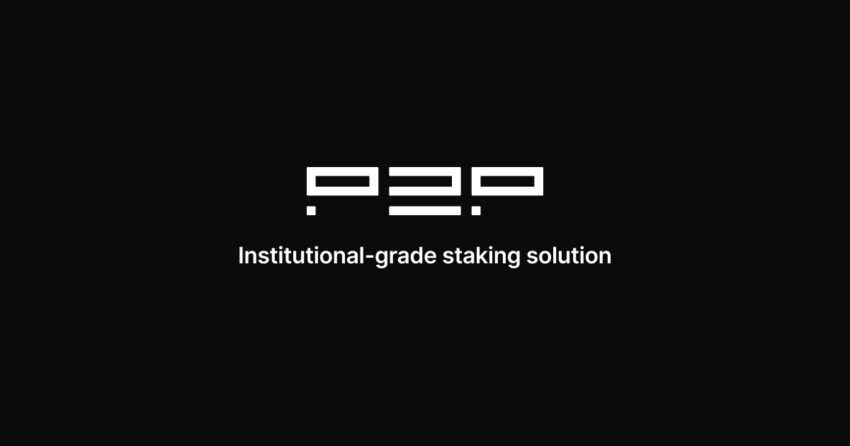
As one of the largest validators in crypto, P2P Validator is an all-in-one institutional-grade staking solution. Over 7,000 active validators launched across more than 40 networks, including the Ethereum blockchain. Other products include RPC nodes, staking with insurance, and white-label nodes.
The company was founded in 2018 with the goal of positively impacting the development of proof-of-stake technologies. Since their inception, they have grown to manage over USD 4 billion in staked assets across over 20,000 investors and over 25 distinct blockchain networks.
Rewards distribution
On staking networks, P2P charges reward fees. Fees are only deducted from rewards, not total staked amounts, so staking with P2P benefits you. The rewards and fees they provide vary depending on the network. For the Ethereum network, the rewards are about 5.4% APR. The rewards are paid out throughout the year and not in one lump sum at the end of the year. The platform takes a 10% validator fee.
What you should know
P2P Validator is one of the oldest validators in crypto, going all the way back to 2018 on the Tezos network. They are a verified provider and have a AAA SR Rating. The SR Rating is part of the Staking Rewards’ Verification Program for Staking Providers. Making the rating public aims to strengthen the verification process’s transparency and better distinguish the verified providers based on an evaluation of their business practices.
| Platform | Centralized/Decentralized | Custodial/Non-Custodial | Fees | LSD |
|---|---|---|---|---|
| Rocket Pool | Decentralized | Non-custodial | 5-20% | Yes |
| Lido | Decentralized | Non-custodial | 10% | Yes |
| Kiln | Centralized | Non-custodial | Degressive fee that starts at 8% | No |
| Coinbase | Centralized | Custodial | 25% | No |
| Allnodes | Centralized | Non-custodial | $5 per month | No |
| Binance | Centralized | Custodial | 5% | Yes |
| Stakewise | Somewhat decentralized | Non-custodial | 10 DAI per validator and a 10% commicsion fee | Yes |
| stake.fish | Centralized | Non-custodial | 0.1 ETH | No |
| P2P Validator | Decentralized | Non-custodial | 10% | No |
Will Ethereum staking offer lucrative profits in 2025?
Cryptocurrencies and blockchain technology are entering the mainstream like never before. This is partly due to their alternative to the traditional banking system. The trend is set to continue in the near future.
By most estimates, Ethereum will continue to be one of the most important actors in the crypto space. Its change to a PoS mechanism and the introduction of sharding technology are bound to improve the network and the ecosystem around it. With all of this in mind, it could be profitable to stake Ethereum in 2025.
Frequently asked questions
How much do you get for staking Ethereum?
Is staking Ethereum a good idea?
Is staking your Ethereum safe?
Where should I stake my Ethereum?
Can you stake your Ethereum?
How much do you get for staking Ethereum?
What is the best platform to stake Ethereum?
How can I stake Ethereum?
Can I stake Ethereum on Binance?
Disclaimer
In line with the Trust Project guidelines, the educational content on this website is offered in good faith and for general information purposes only. BeInCrypto prioritizes providing high-quality information, taking the time to research and create informative content for readers. While partners may reward the company with commissions for placements in articles, these commissions do not influence the unbiased, honest, and helpful content creation process. Any action taken by the reader based on this information is strictly at their own risk. Please note that our Terms and Conditions, Privacy Policy, and Disclaimers have been updated.


